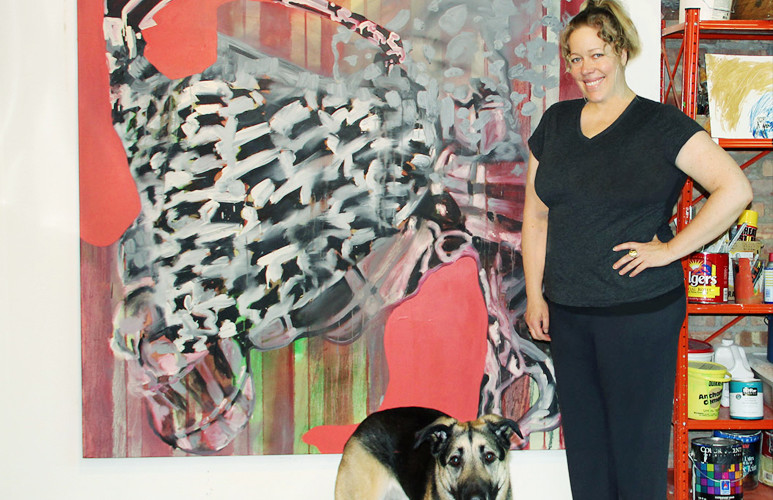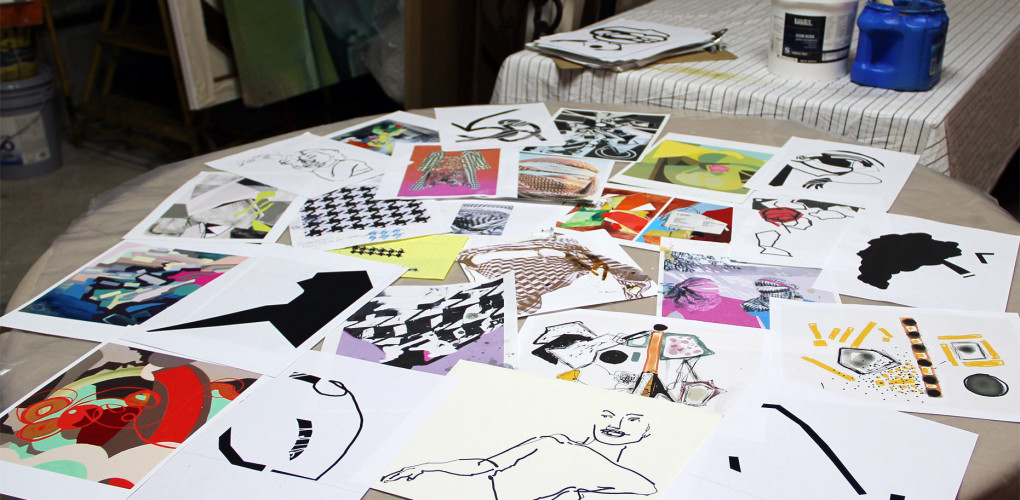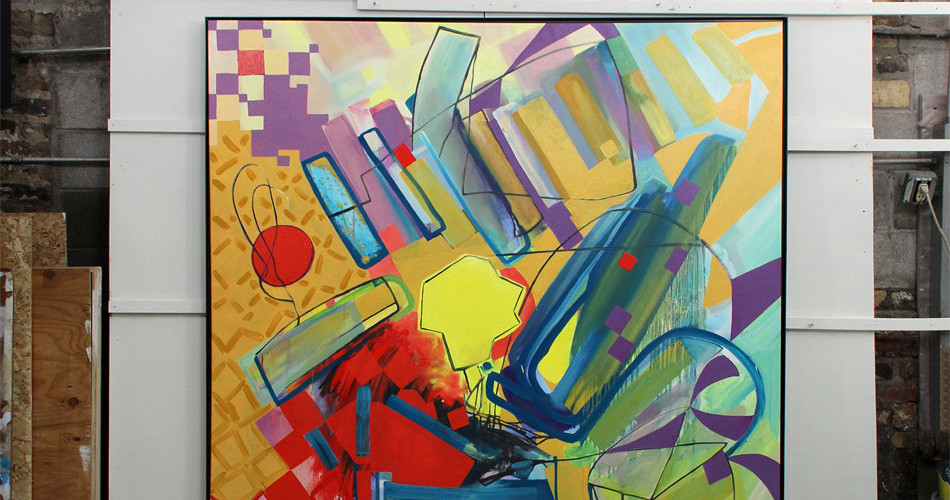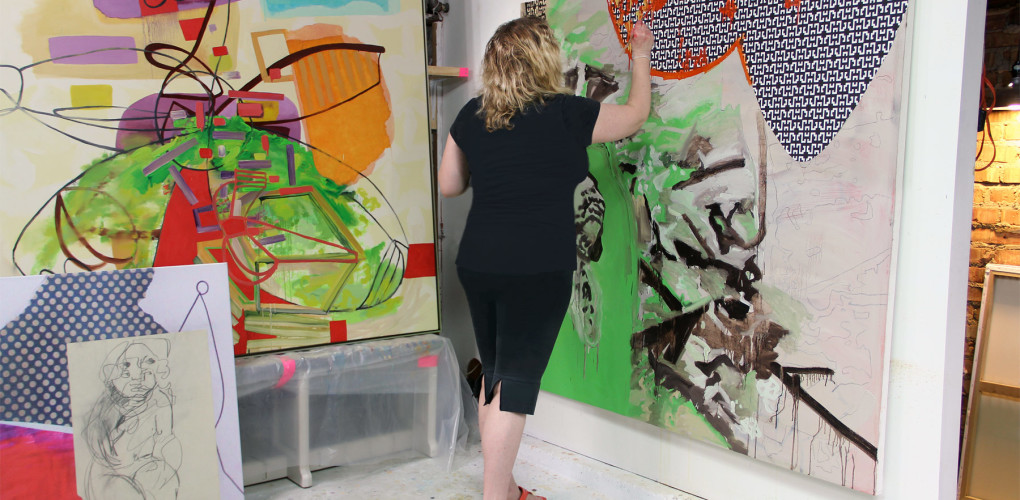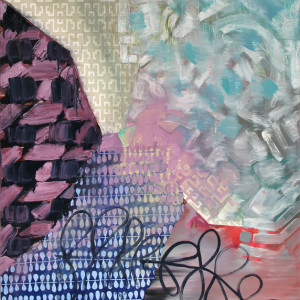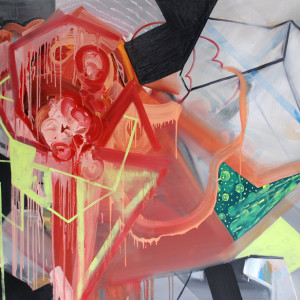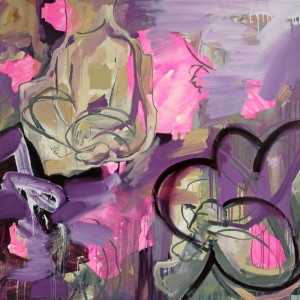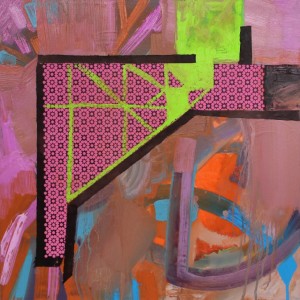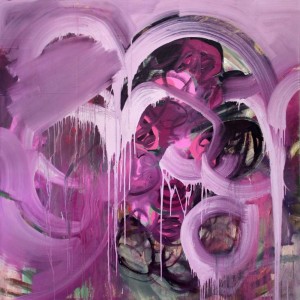Inside the Studio
 Pamela Staker
Pamela Staker
Favorite material to work with?
I am a materials junky. I love to mix anything and everything that interests me onto canvas or paper. Most of what I do would fall under the category of “mixed media” yet I find that description by itself insufficient. In the media section I list everything that actually goes into each piece. I like the transparency of having that information available in case it’s of interest to young artists and clients. Sometimes the description is as simple as oil & collage on canvas. For the works on paper, however, I usually have a laundry list of conventional and unconventional materials such as acrylic, graphite, charcoal, duct tape, vinyl wall covering material, foam core, decorative paper, etc… The only guideline I have when mixing materials is that they be as archival as possible. Experimentation is an important part of the work but I also want my art to hold together over time, so I prioritize using high quality materials.
How many years as an artist?
I’ve been an artist my whole adult life. I went to the University of Illinois as a math major and switched to fine art half way through. My roommate at that time was a painting major and I knew immediately that going into painting was what I wanted to do and I have never looked back.
What themes do you pursue?
I pursue abstraction, using pattern, geometric shape, bold color combinations and expressive line work to build my compositions. I am energetic, fast and intuitive when I work. This helps me to curb any inhibitions or self-consciousness in the process. I am interested in laying down a brush stroke, line or shape and letting it be what it is without second guessing or overworking it. After each work session I will spend as much time as needed looking at and thinking about what I have just done – figuring out what is going on in the work and where this will lead me next. Sometimes I only have to spend a day or two with an unfinished piece to see how to move it forward. Occasionally I will spend months with a painting before knowing where to go next. I embrace the imperfection and spontaneity in this process. My mind can be restless and lose interest quickly – this process keeps me on my toes and always curious, never bored.
What was the best advice given to you as an artist?
The best advice given to me was that I needed to value and prioritize my studio time because no one else was going to. I found this to be especially true in the beginning. So many distractions and prejudices can derail a vibrant studio practice. Being a full time artist was never really considered a legitimate choice in my family. There were all kinds of fears around what that might mean and a lot of expectation to have a “real job” first and make art on the side. While I did go down that path for a while, that way of thinking was never really a good fit for me. In the end I made a decision and took responsibility for what I wanted to do, tried to let go of the internalized fears and struggles (easier said than done) and went for it. The reason this advice turned out to be so important was that it helped me to maintain a consistent studio practice while I worked out the kinks and for that I am grateful.
Prefer to work with music or in silence?
I prefer silence, especially when I am actually making the art. When it is quiet in my studio, I feel like my sense of space and ability to get lost in my work is expansive, peaceful and open. Any noise tends to crowd me and take me out of being present for my work. If I am doing more mundane tasks in the studio like cleaning, making stretchers and prepping to paint I will sometimes listen to music or NPR.
Art school or self-taught?
Both. I loved my art school experience though it was hard come critique time. Critiques could be brutal, but this prepared me to do good work and stay tough when necessary. I was also able to earn the respect of my peers, which was no easy task. Without this experience I would not have been properly prepared to weather the amount of rejection and hardship that comes with being an artist. As for self-taught, I believe that finding new ways to do things on my own, keeps me creative. I often come up with interesting solutions by trial and error that never would have occurred with a more formal and trained approach. I try to stay teachable and always open to new ideas about how I work.
Prefer to work with music or in silence?
I prefer silence, especially when I am actually making the art. When it is quiet in my studio, I feel like my sense of space and ability to get lost in my work is expansive, peaceful and open. Any noise tends to crowd me and take me out of being present for my work. If I am doing more mundane tasks in the studio like cleaning, making stretchers and prepping to paint I will sometimes listen to music or NPR.
Where is your studio?
I have a work/live space in Chicago’s Pilsen neighborhood, which is just south of downtown and known for its artist population. Even though it is very centrally located in Chicago, Pilsen has never become overly gentrified and therefore is still a lovely and affordable place for artists.
Where can we find you outside the studio?
At a coffee shop or at the dog park.
If you couldn’t be an artist, what would you do?
I honestly don’t know. I am perfectly suited in my personality and temperament for what I do. I suppose I could imagine a job working with animals or wildlife in some capacity – maybe becoming a bee keeper – that’s weird enough for me!
Favorite contemporary artist?
I look at tons of art and have a wide ranging list of people that inspire me. Albert Oehlen is by far my favorite painter. I also really enjoy the work of Olaf Breuning (especially his smoke bomb photographs), Finish photographer Esko Männikkö, and Radcliffe Bailey. There are also many emerging artists that I am interested in including Sigrid Sandström, Cordy Ryman, Trudy Benson, Shara Hughes and Leslie Baum to name a few.
Use anything other than paint?
Yes – absolutely! I will use any material available to me as long as I can build a picture that is reasonably archival.
Is painting dead?
No – that is a ridiculous and hilarious assertion. Every time I hear something like this I get an image in my head of a rebellious teenager having some kind of knee jerk reaction against painting (traditional form of art expression). I think ideas are always evolving over time, but they are also on a circular continuum and depending upon where we find ourselves in life then painting is either all the rage, somewhere in between or being declared dead. These are predictable occurrences. Successful artists find what expression makes sense to them and then they pursue that creative outlet regardless of what is fashionable at the time.
Favorite brush?
The cheaper (hardware store type) the better, because I go through them really fast.
Palette knifes?
Definitely not – I am coming out against palette knives.
